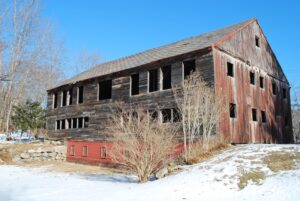Who is a member?
Our members are the local governments of Massachusetts and their elected and appointed leadership.

A program in Amherst encourages residents to preserve older barns and other outbuildings. (Photo courtesy town of Amherst)
A new program in Amherst aims to save a disappearing vestige from the town’s agricultural past: the old barn out back.
In April, the Amherst Historical Commission launched the Barn Preservation Program to help residents defray the costs of historical assessments for barns and other outbuildings that add to the town’s bucolic character. Under this program, Amherst will pay 50% of a structure’s historical assessment, or up to $500, for more information about the structure’s history and preservation needs.
The program, which Amherst officials believe might be the state’s first, aims to reverse a trend of barns disappearing due to disrepair and demolition. By encouraging the assessments, officials said, they hope to help residents see the value of saving these older structures while envisioning new uses for them.
“The number of barns has really decreased, and the rural history of Amherst is so important,” said Walker Powell, the Historical Commission’s planner. “We wouldn’t want that to get lost in the sort of development pressure that we’re facing right now … and lose out on the outbuildings, which really help create the character of the town and show the history of the town as a farming community.”
Powell said she has about 80 barns and outbuildings on her list — ones that are visible from a road and might benefit from preservation — but the actual number could be higher. The very oldest barns date back to the 1700s.
“Barns represent the history of many people who were instrumental in making Amherst the community it is today,” said Jan Marquardt, former chair of the Historical Commission, in a statement about the program.
In recent years, the commission has seen more demolition applications for older barns and outbuildings. In cases of demolition by neglect, commissioners have little choice but to approve the applications, officials said.
The commission has researched similar programs in New Hampshire and Vermont. In 2023, it received $10,000 in Community Preservation Act funds to support the historical assessments.
To qualify for the program, the outbuildings must be at least 75 years old and owned by Amherst residents. Eligible structures include barns, garages, carriage houses, and other non-residential outbuildings.
The assessments will examine the buildings’ structural integrity, offer estimates for needed repairs, and provide information on construction materials, as well as the buildings’ functions and historical significance. The town also offers a list of contractors qualified to provide the assessments.
The second hurdle is convincing residents to see these buildings as desirable hallmarks of their properties, not as headaches that are expensive to repair, take up too much space, or prevent the construction of modern replacements. Officials point out that the outbuildings add to a property’s appearance and historic charm. Even if owners no longer need the barns to house livestock or bales of hay, officials said, people can reimagine them as storage spaces, garages, or accessory dwelling units.
Powell said property owners can apply for CPA funds for assistance with historic barn projects, or research state grants or other funding sources.
Amherst had received three applications as of mid-May.
The Historical Commission is considering organizing barn tours, similar to historic house tours, and talks about the barns. Another idea may involve creating a poster or calendar to celebrate the barns.
“This is a resource that is disappearing, and it’s not getting replaced,” Powell said. “And I think it’s a super valuable resource, especially in New England. It’s really a key part of the history of the area.”